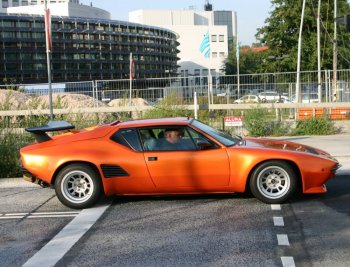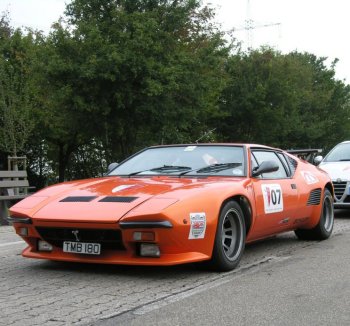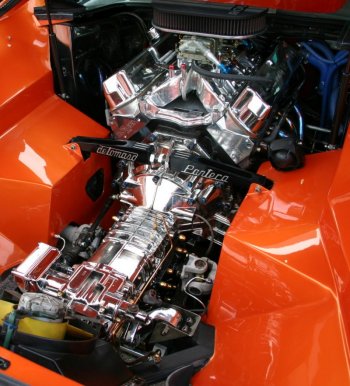|
One of the highlights of the
MPH Classic show which opens at Earls Court on
Thursday (2nd November) will undoubtedly be a stunning and
unique De Tomaso Pantera, one of the finest and most
developed examples of this evocative Italian supercar. The
attention-grabbing Pantera will be one of four powerful
sports cars being presented by London Design and Tuning
House Autodelta at the MPH Classic, three of them
which are cars that took part in last month’s Autodelta
European Tour 2006. MPH Classic is a brand new
section of MPH06, and it will see more than 400
important classic sports cars gathered together to form a
fabulous and valuable gallery of motoring greats.
The evocative and unique De Tomaso Pantera belongs to
enthusiast Roger Coates–who along with his wife Melanie–took
part in last month’s Autodelta European Tour 2006,
which saw a select group of high-performance sports cars
travelling from London, across Europe, and to a finish in
Monte Carlo, with overnight stops in Holland, Germany and
Switzerland along the way. The other two Tour cars at MPH
Classic this week will be the Ferrari 348TB (car 05) and
Alfa SZ Supercharged (car 10). During the Tour, the Pantera
(car 07) certainly won the award as the loudest entry, the
rumble of its specially-built Roush V8 shattering the early
morning peace and dragging locals from their beds on an
almost daily basis.
The Pantera is undoubtedly the classic De Tomaso model, most
probably due to its initial commercial success deriving from
the deal with Ford. The replacement for the Mangusta, it was
introduced at the New York Motor show in 1970 and was
marketed through Ford's Lincoln/Mercury dealer chain in the
USA. This saw 6128 examples being produced by the end of
1973, a volume which was reduced to the more normal exotic
car dribble in 1974 when Ford withdrew from the deal.
The
Pantera used the same mechanical layout as the Mangusta,
with a mid-mounted 5769cc V8 driving the rear wheels, but
the chassis was much superior, being developed mainly by
Dallara. Independent suspension and disc brakes were
employed on all corners, whilst the body was of unitary
construction, designed by Tom Tjaarda of Ghia. The
accommodation was also roomier, and had such luxuries as air
conditioning as standard. During the extended production
life of the Pantera various levels of engine were used, from
266bhp in the most emission strangled US unit to 500bhp in
the GT4 version. In 1990 a heavily revised version was
released. The mechanicals remained effectively the same
(although the engine was now a 4942cc unit with 305bhp and
various changes were made to the brakes etc) whilst the
external styling was facelifted by Marcello Gandini. A
450bhp twin turbo version was also offered. Only 38 of these
final versions were built. Total production had reached 7260
cars when it ceased in 1991.
Roger
Coates is a car enthusiast who was bitten by the Pantera bug
25 years ago–at the tender age of 19. “I was on holiday with
my parents in France,” he says. “There was a Pantera parked
outside the hotel right opposite our campsite. I was hooked.
I thought I will never be able to afford one, but from that
moment on I desired to own one.” Fast forward and Roger is
now a successful businessman and garage owner. “A friend in
car sales called me up and said he’d just taken a Pantera in
part-exchange. Anyway, the result was that we quickly did a
deal. It was a rot box and mechanically unsound, and so I
spent 10 years slowly restoring it. The engine was rebuilt
and fitted with a twin Magnussen supercharger, which turned
out to be a pretty unreliable arrangement; particularly as
due to the lack of engine bay space a shaft had to be run to
the back of the engine, a set-up that had a tendency to
regularly shed belts.”
|


 |
|
The
evocative and unique De Tomaso Pantera belongs to
enthusiast Roger Coates–who along with his wife
Melanie–took part in last month’s Autodelta
European Tour 2006, which saw a select group of
high-performance sports cars travelling from London,
across Europe, and to a finish in Monte Carlo, with
overnight stops in Holland, Germany and Switzerland
along the way. |
|
|

 |
|
One of
the highlights of the MPH Classic show which opens
at Earls Court on Thursday (2nd November) will
undoubtedly be a stunning and unique De Tomaso
Pantera, one of the finest and most developed
examples of this evocative Italian supercar. |
|
|
Never
one to choose the safe option Roger then bought another
Pantera, This was a basket case which came with 20k’s worth
of new parts; the car was sold but the parts retained and
they were used on his third purchase, which was the
“Lamborghini Orange” finished car which took part on the
Tour. He bought this Pantera from a customer who came into
his garage for a service, and again it was another long-term
‘strip-down and rebuild everything’ job. The car was painted
in a brand new blue paint, which changed to green depending
on the light it was viewed in. Disaster struck spectacularly
when a brand-new tyre blew out on its first test run,
spinning it on a roundabout and seriously damaging the car,
with 25K of damage occuring.
Undeterred–and a new front and rear end, wings, bonnet and
boot later and another lengthy period of time–and the
Pantera was back on the road again. However there was to be
another disaster still lurking round the corner: “Last
Christmas,” says Roger, “I heard an almighty bang from the
garage. The row of fitted cupboards right down one side of
the garage had come away and landed on the car–and one side
of it was somewhat dented.
Time for
a different approach. “I decided to rebuild the car, but
chose to fit while the work was going on a new engine
supplied by famed US engine builder Roush. “A friend put me
in touch with John Christian from the Roush racing division.
He was a serious Pantera enthusiast and oversaw the build
project. The 539 bhp (511 lb/ft torque) Roush-built
6.6-litre V8 was shipped over and fitted, and the
restoration in fact was completed just a week before the
Tour was due to begin. To match the look of the new engine
the gearbox was chrome-plated–the result is a truly awesome
visual feast; every time Roger lifted the tailgate during
the Tour a crowd quickly clustered around. And while the
engine was being built Roger also took a new approach to the
bodywork: carbon fibre bumpers, grilles, spoilers and door
mirrors were designed, fabricated and fitted, replacing the
“goldplated” components used during the first restoration.
“It was
pretty tight timing,” says Roger. “We only drove the car
only once before the Tour. My son Andrew is at Wolverhampton
University, so Melanie and I took the car over from our
Leicester home to visit him. We did the journey in 40
minutes flat, but the car was baking hot so we spent two
days replacing seals and recharging the air-con system.”
Roger was now ready for a 1,400 km race across Europe.
“The car ran faultlessly throughout the event,” he says.
“The only minor problem we had was a carbon fibre door
mirror falling off – the incorrect adhesive had been
supplied. It was simply lovely to cruise in, at around 80
mph, although it was a little bit rough at idle.” This was
due to the existing carburettor having not being set up
exactly correctly for the new engine, he says. “Since
returning from the Tour I have spoken to Roush, and John
[Christian] went straight to the company President to
discuss the issue. The net result is that they are now
building a carburettor which will be perfectly set up for
the engine, and tuned for driveability and performance. I
have to also add that I have never dealt with such a good,
responsive company, and in particular John has
enthusiastically embraced my project. The engine quite
simply speaks for itself.”
The car
caused a sensation on the Tour, always heard long before its
sleek bright orange form hove into view. “On the Autobahn at
one point we strolled by a DB9–which was pushing it–like it
was standing still; this car is peerless, well worth the
efforts and heartaches,” concludes Roger.
The Autodelta European
Tour – and the De Tomaso Pantera - will be represented at
MPH Classic at Earls Court (2nd-5th November), on the first
floor of Earls Court 1, Stand No CS04.7 The new Autodelta
Brera J5 3.2 C will be on display on Stand No S21. Jano
Djelalian and the Autodelta team will be on hand to discuss
the car and answer questions. For further information on
Autodelta visit
www.autodelta.co.uk/.
For further information on the Autodelta European Tour visit
www.autodeltatour.com.
|
|
|
|